Reproduction with Hormones Flashcards
Female Reproductive Structures

- Ovary attached to ligaments but not fallopian tubes just hangs around it w/finger things
- Ovary releases an egg in ovulation into abdominal space and usually ciliated columnar epithelial will beat enough to bring egg down fallopian tube to start path toward uterus
- If egg falls into abd and fertilized there it can be ectopic pregnancy or if egg implants in wall of fallopian tube
- Uteran wall has outer surrounding membrane called parametrian and them myomedrian which is smooth muscle and then inner layer is the endometrian (thicker and more vascularized and then sluffs off again)
- Uterus ends in cervix, extra thick layer of muscle

Uterus Types
- Uterus in diff varieties depending on animals
- In some organisms there’s a double uterus (rats, mice, rabbits)
- B. single uterus w/split and found in animals w/litters – dogs, cats, cows – implantation all along uterine horn

Structure of Ovary
- Ovary – @ birth female have primary follicles frozen in prophase I
- In normal cycle: 10-20 follicles begin to grow; follicle cells around primary follicle, replicate and make thicker layer over time
- As follicle matures and makes more follicle cells, it creates spaces in layers of follicle cells, and that space around developing follicle is called the antrum
- Eventually antrum is large and follicle cells are growing begin secreting estrogen
- In each cycle as follicle gets larger and larger there is more estrogen in the blood; midd of cycle before ovulation, antrum and follicle are large and follicle will bulge out wall of uterus
- At ovulation the thin area will break open and oocyte w/associated follicle cells will fall out – attached follicle cells are called corona radiate
- Then its swept into opening and end of fallopian tube in mean time the residual follicle cells reorganize and become a corpus leteum (yellow body), which is an endocrine organ that secretes estrogen and progesterone
- In corpus leteum there is an internal timer, after 10 days after release of ovulated oocyte, it degrades and breaks down to form white scar structure called corpus albicans which stays in ovary for rest of life of woman
- White spots are representing all the previous cycles she went through
- When corpus leteum breaks down it stops producing and releasing progesterone and estrogen

Reproductive Hormones and Organ Changes
•Secretory pathway: Hypothalamus (at base of brain) which secretes a signal molecule called GnRH (gonadotropin releasing hormone) that affects the –> anterior pituitary gland and that is signaled to release reproductive involved hormones called FSH (follicle stimulating hormone) and LH (leuteinizing hormone) –> target organ like the ovary
- FSH and LH from anterior pituitary gland (@ base of brain) and this is levels of them in the blood
- 28 day cycle w/ovulation in middle at 14 days•
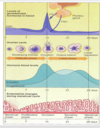
Follicle Phase and then Luteal Phase
First is the follicular phase since follicle is developing and second half of cycle is luteal phase since controlled by action of corpus lituem
•Blood levels of hormones from the overy – estradiol and progesterone
•Then shows what happens in wall of uterus in endometrial layer – at beginning of cycle is onset of menstration phase, wall of uterus is sluffing off to make the period, then new cycle begins
•At beginning phase, the FSH is little higher than LH, and FSH tells primary follicles to begin to grow and the replicating follicle cells secrete more estragen which causes the endometrium of uterus to thicken and become vascularized
•Estrogen gets higher and FSH and LH get lower
•At mature follicle then a surge in LH which causes the ovulation and break open the follicle and amount of estrogen by follicle is < and then becomes corpus leteum and produces estrogen and progesterone which go up are produced by corpus luteum

Luteal Phase
- Oocyte travels down fallopian tube, and lining of uterus is prepped for pregnancy
- In leuteal phase estrogen and progesterone are high and feedsback to pituitary and inhibits release of FSH and LH so inhibits release of additional follicles – same basis for birth control which inhibits release of LH and FSH to prevent new ovulation by secreting progesterone and estrogen
- Timing of corpus leteum runs out and turns itself off and forms corpus albican which ends estrogen and progesterone ; fall off of progesterone causes the start of menstrual phase
- Before end of timing period, i_f fertilization occurs a signal comes to corpus luteum to rescues and won’t progress and degrade_

Regulation by Hormone Feedback
- feedback inhibition here too

Human Chorionic Gonadotropin (HCG) - rescues corpus leteum
- Estrogen and progesterone both up in second half of cycle - luteal phase
- Near end of cycle and pregnancy has occurred and hormone called HCG (Human Chorionic Gonadotropin) is secreted by the chorion the outerlayer of developing embryo ; acts on corpus leteum and said to rescues the corpus luteum and progesterone and estrogen won’t drop off and wall of uterus will maintain itself and corpus luteum from self-destructing
- Estrogen as preparing the wall of the uterus via cell division and vascularization
- Progesterone hormone – maintains the wall of the uterus so when it falls off you get start of menstration

Early in Pregnancy
- Oocyte passes into fallopian tube and fertilized in tube and then travels down as it goes through cleavage, blastulation, and gastrulation and in uterus its passed blastula stage and inner cell mass (w/synchitrophoblast cells dissolve into wall of uterus) and interactions here cause the chorion to secrete HCG and that’s the signal that pregnancy has occurred
- HCG is hormone you detect in home pregnancy test, sticks to antibody there and turns it plus (pregnancy work 10-12 days after fertilization since takes time to implant
- You can buy morning after pills – do diff things; some are intended to prevent ovulation itself if in mid of cycle; some prevent ovulation for 5 days since sperm don’t live that long
- Prevent implantation – irritate wall of uterus so implantation doesn’t occur
- Competitively inhibit binding of progesterone; blocking progesterone signal, then wall will sluff off and menstruation will start even if implanted embryo there
- HCG is similar to LH – use urine sample and if rabbit ovulates then know HCG is in urine
- LH surge to test for ovulation

Menstral/Ovarian Cycle
- Menstral /ovarian cycle – humans and primates
- Estrous Cycle – used by other mammals, shorter luteal phase (2nd part of cycle) – less endometrial build up so no menstral phase ; period of heat which represents period of receptivity; interest and ability to reproduce is only during period of heat – seasonal in many kinds of mammals, ex. Deer in fall once a year; other animals have heat period 3 to 4 times a year
- Deer have monstrous cycle but some other animals are polyestrous like mice and rabbits (every 1-2 weeks have heat period all year long)
- We are placental mammals vs. marsupial mammals
Reproduction in marsupial mammal
- Placental vs. marsupial (pouch) mammals
- Developmental time period of marsupial go from fertilization to period of weaning; shorter gestation and longer lactation
- Fertilization to birth is called gestation and short (8-15 days in marsupial) and then young are born and very undeveloped except forelimbs and drag selves into pouch and then period of lactation in pouch, very long for birth to weaning
- Placental mammal is reversed, period of gestation is longer and lactation is shorter where birth separates the two
- Placental mammals out competed marsupial mammals due to greater developed young of placental mammals
- Teets for young kangeroo and for older young
- Can freeze development – embryonic diapause, until older child is weaned and then small baby gets more developed
- Kangaroos carry 3 babies at 3 stages of life at same time

Twins
- Ways to form twins – less frequent as move down diagram:
- 2 eggs ovulated at same time and both get fertilize and both implant
- Monozygotic/identical twins – fertilized egg in first division is split at 2 cell stage and each forms embryo and each implants in wall of uterus
- Split happening later? Forms blastula w/inner cell mass and before its established there’s a split w/2 inner cell masses in one blastula and so when implants then get 2 amnions
- Cell mass doesn’t split much so 2 embryos in same amnion w/2 umbilical cords w/same placenta - siemes twins
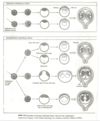
Cleavage Stages
- Fertilize egg, then first division of cleavage which occurs after 30 hours
- 60 hours get 4 cell stage
- Blastula/blastocyst (fluid-filled cavity) have 4-6 days : have inner cell mass and trophoblast cells
- Blastula stage and zona pellucida goes along and then it degenerates around 6 days – 7 days and then the embryo itself hatches and breaks out of zona pellucida layer which allows cells of trophoblast layer to interact w/walls of uterus for implantation

Implantation at about 1 week
- 6-7 days and have inner mass formed and is blastula and sincytiotrophoblast are on side where wall of uterus and digest their way into the wall – embryo moves into the wall here
- Lots of cells and blood vessels
- No zona pellucida at this point
- Receptors between trophoblast cells and uterine wall then starts drilling in w/sincytiotrophoblasts
- Can’t implant unless hatch out of zona pellucida layer, if hatch too early then embryo might implant in fallopian tube, want timing right

Development of Chorion and Early Placenta
- Inside wall of uterus now not sticking out
- Sincytiotrophoblast cells that ate way in
- Inner cell mass drops down and form amniotic cavity
- Yolk sac and surrounding membrane and chorion and sincytiotrophoblast cells reorganize selves and form a placenta – chorionic villi are formed which > SA between embryo and surrounding uterus wall
- Stalk between developing embryo and outer layer which is the placenta
- Can detect pregnancy around 10-14 days

Weeks of Development
- Length of dev is 38-39 weeks total
- Week 2 amnion formation and discoid cleavages and see primitive streak
- Week 3 have neurulation and have central nervous system forming and dorsal hallow nerve chord but no brain and somites and some heart structures (brachial slits forming)
- 4-5 weeks have limb buds
- Thalidamide affects the limbs and was originally for woman w/morning sickness around 4 weeks and where limbs grow too so birth defects in limbs
- brain at 9 weeks
- CNS completing at 20-39 weeks
- Sense of what forms when
- Don’t need to reproduce diagram just general sense

Gastrulation to Neurulation
•at 2 weeks See primitive streak and as it draws back the part at head finishes gastrulation and
- at 3 weeks forms neural groove and forms around and gets neural tube w/opening at one end w/brain and then other end closes up and somites in middle
- Spina biffada is where other end fails to close
- If no brain forms and unfinished neural tube then get anencephaly - no brain
- at 3.5 weeks the pharyngeal arches are seen
•Needs to zip closed at both ends

Neural Tube Defects
- around 3 weeks can see anencephaly or spina bifida
- Fewer neural tube defects if take folic acid a vitamin B supplement which seems to help w/and replication and some blood cell formation
- Failure to close at head end of neural tube then have anencephaly
-
Fail to close at other end it depends how far down it has closed for severity of spinabiffada disorder
- Could get bubble w/cerebral spinal fluid and problems in lower body; but sometimes fails to close at end and little opening and dr. can close that up by folding up into the tube

Week 4
- Limb bud starting to appear and heart coming along and will start beating
- Connection to umbilical cord
- Remnant of yolk sac is compressed into umbilical cord and is absorbed and closed up
- Digestive tract
- And allantois is 4th embryonic membrane – stores nitrogenous waste
- Placenta has thin walls between baby’s and mothers circulation – waste can diffuse across most of waste

Weeks 5-6
- yolk sac is shunk and absorbed and thin tube and now yolk space is becoming digestive tract
- limbs more formed but hands and feet are flippers
- retina forming

External Genitalia- at 7 weeks uncomitted
- At 7 weeks form of genitalia structures are uncommitted
- If Y chromosome is present then penis will develop around 10 weeks more formed through birth
- w/out Y then same structures but clitoris forms and remains open not closed
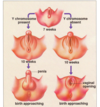
Internal Reproductive Structures
- 7 week embryo there are tubes that developed that are uncommitted – wolfian duct and mullerian duct and pre-gonad structures (testes and ovaries develop in same spot in abd) – gonad become testes and wolfian duct becomes vas deferins and mullerian ducts fade if Y chromosome and then area at bottom becomes prostate and urethra
- If no Y chromosome – get wolfian ducts that go away and mullerian ducts become the fallopian tubes and area below becomes uterus and vagina and gonad becomes ovaries
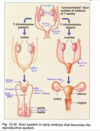
Embryonic Membranes and Placenta
•Embryo w/inner cell mass beginning to drop to make amniotic cavity
- Sintrophoblasts begin
- Chorion beginning to form and make chorionic villi and maternal blood is hooked up to spaces that connect between spaces of villi and called blood islands so maternal blood can be right against villi to help < distance for diffusion; mother’s circulation breaks down some surrounding layers around the blood vessel (usually endoderm and connective tissue) but here blood just spills into blood islands – call maternal layer of placenta the decidua (to drop a couple layers to get its blood right against chorionic villi)
- Embryo is connected by body stalk that becomes the umbilical chord and still little yolk sac that becomes incorporated into umbilical chord but not major source of nutrition that is the placenta’s job
- Placenta works as waste diffusal system
- Allantois is inside the embryo and was storage for nitrogenous waste but is shrinking now
- Yolk sac still present
- Embryo layers of endoderm, mesoderm, ectoderm on top and little nervous system is forming
- Other stuff at bottom (extra embryonic mesoderm – don’t worry about it)

Placental Circulation
- Umbilical chord
- Chorionic villi w/fetal circulation going through; surrounding that are spaces w/maternal blood called maternal blood islands
- Never are they continuous w/each other
- Placenta ends up on one side of the embryo
- Embryo was embedded completely and then bulges out into uterin space and surrounded by amnion (constituted from the urine of the child)
- fused amnion and chorionic membranes

Fully developed amnion
- placenta off to side and then see bulge of amnion

Fetal Vs. Newborn circulation
•In utero as fetus the lungs are not working; do not oxygenate the blood at all; oxygenated blood comes across placenta and through umbilical vein (shown in red) and enters umbilicus and travels through liver and R side of heart and want to get to L side of heart to pump to body to use since oxygenated;
- opening between 2 chambers of atrium and blood crosses hole into atria and then out aorta to body;
- hole in heart is called foramen ovale which is present when you’re a fetus so blood doesn’t go to lungs
•Blood that comes into R ventricle gets pumped out pulmonary artery but bypass in fetus that connects pulmonary artery to aorta and out to body; bypass structure is called ductus arteriosus
- Get oxygenated blood out to aorta
•R side of heart usually receives unoxygenated blood from body and goes to lungs
•After birth need to get blood from R side to lungs to be oxygenated ; umbilical vein shrinks into ligament
- So blood comes into R side of heart and then into R ventricle and out pulmonary artery and over to both lungs and the ductus bypass forms a ligament since is shrunk and non-usable
- Hole in the heart and foramen ovale is closed w/high pressure since baby in air and grows closed and is overlapping flap and fosa ovalus is indentation of heart is remnant of where was an opening
- Baby w/hole in heart is foramen ovale that fails to close

Major Pregnancy Hormones
•Placenta is life support system for the fetus and becomes its own endocrine gland – produces progesterone and estrogen
- Embryo trophoblast cells do not make cell surface markers so mother’s immune system can’t see the baby
- Progesterone inhibits any production of prolactin which usually says make milk
- Estrogen and progesterone also signal to get ready for milk production but not time yet
- Placental lactogen – stimulates development of milk ducts, promotes fetal growth and alters the metabolism so the mother uses fat more for nutrition so baby gets the carbohydrates
- Inhibits anti-diretic hormones – causes you to pee more
- Early in pregnancy the hCG levels > and secreted from chorion and rescued the corpus lutium which secrete progesterone and estrogen to maintain uterine cell wall
- Placenta that matures produces its own estrogen and progesterone and supports itself
- hCG begins to fade away as to corpus lutium but enough from placenta to maintain itself

Development General
1) 9-10 weeks the embryo becomes a fetus
2) 12th week – recognizable facial features, legs are moving but no kicking yet but most standard recognizable features are present
3) 2nd trimester (4-6 months) about 7-8 inches long and around 4-5 months child starts kicking
Body w/ think layer of hair that is pale and short and fine and called Lanugo (remnant trait of when we were all fur covered) - normally it is gone and reabsorbed by the time of birth
Heartbeat can be detected w/stethoscope (180 – very rapid heartbeat)
4) 3rd trimester : growth, brain development, requires lots of nutrients - lots of pruning and connections as brain gets mature it eliminates connections its not going to use which is pruning ; if suffer from malnutrition as mother then has very deleterious effect on the developing brain of fetus ; don’t want brain too big because has to fit through birth canal
Regulation of timing of birth
- Actual signal for onset of labor is not well understood
- Measured release hormone level of CRH
- Found release of this hormone assoc w/early or late birth
- If too much of hormone then tend to deliver early and if not enough of hormone then deliver late
- corticotropin releasing factor

Birth aka Parturition
- Wall of uterus begins contractions
- Initial signal for contraction we think is from prostaglandins – we think CRH stimulates release of prostaglandins that then say begin contractions, which force baby against cervix
- Right before delivery baby will turn itself over often so head first
- Head against cervix and cervix has nerve endings and detects increased pressure on cervix and signals hypothalamus and posterior pituitary is signaled to release oxytocin which is dumped into blood and causes smooth muscle contraction which is stronger than prostaglandins
- Baby heads pushed against cervix even more and see we enter a positive feedback loop, stronger contractions, the more baby’s head is pushed down and the more oxytocin is released from posterior pituitary and keep pushing baby down until ready to get out of there
- Cervix is going to have dilation (open) and effacement (thin) – can see state of dialation, need layer of muscle to be paper thin and opening to be 10 cm of dialation
- If push too soon then tearing and damage to the uterus

Preparation for birth
- In smooth muscle cells, some hormones circulating are inhibiting presence of receptors prior to labor
- Receptors for oxytocin are inhibited by other things like progesterone during pregnancy
- Oxytocin – stimulates smooth muscle contraction (Pitocin – used for labor induction)
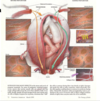
Hormone interacts btwn mother and child
- CRH
- Complex relationship between adrenal gland in fetus that is developing and signals from mother
- Still figuring out how this works – related to maturation of adrenal gland in the fetus – once functional it puts out signals like cortisol which stimulates placenta to release CRH which gets it up to right level

Lactation
- Several hormones in lactation
- First is placental lactogen causes production of milk ducts, estrogen and progesterone were preparing the breasts by enlargering them
- Progesterone was inhibiting prolactin but now delivers placenta and baby – so all that progesterone is gone and mother can release prolactin to synthesize milk
- Colostrum – initial premilk with antibodies and nutrients, Material that is produced in mother’s breast that has nutrients and antibodies from mother’s immune system, so baby gets that first and after couple days the milk comes in
- At first infant can start suckling colostrum material
- Normal, healthy baby comes with pre-packaged nutrients
- Oxytocin interacts w/smooth muscle surrounding milk ducts to help squeeze out/eject milk that is there
- Positive feedback loop as long as baby suckles regularly then will signal around
- Once milk is stimulated to be synthesized by prolactin

Relaxin Hormone And Serum Albumin
- from corpus lutium - loosens fibro-cartilage that occurs in junction btwn pubic bones
- when loosened during birth to allow birth canal to be larger for large mammals like cows
- Some women felt loose jointed immediately after birth ; bit of this hormone in background in humans
- Serum albulin in most humans; acts to carry fatty acids through blood and maintain balance but it turns on right at birth, and before was alpha-fetoproteinand that switch happens at birth
- Some evidence that alpha-fetoprotein may be involved in brain development
- psychological component of release of oxytocin - sometimes if mother is breast feeding and hears other baby cry they will release milk suddenly
- Lactation inhibits FSH and LH then no additional ovulation will occur which gives us natural way to space out children and in many cultures this is the only birth control they use which will space out their baby by lactating 3 years – unreliable method
- Breast feeding as long as it continues will continue as long as child keeps drinking milk - positive feedback system
- If miss a day or two of breast feeding sometimes that is signal and milk production will stop so for this reason women use breast pump to keep milk production


